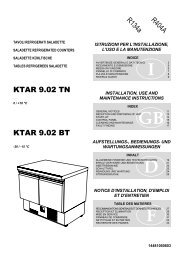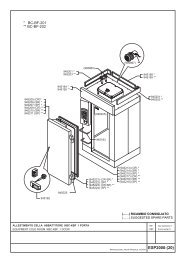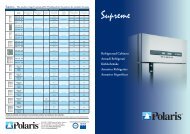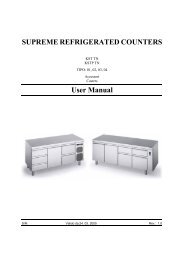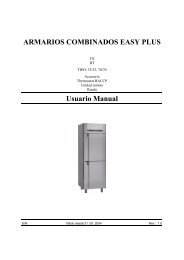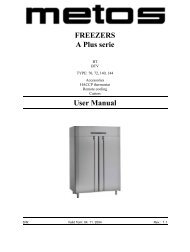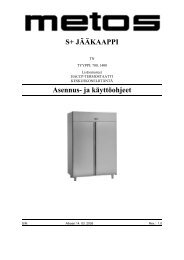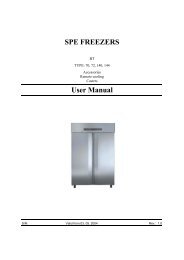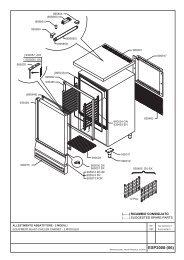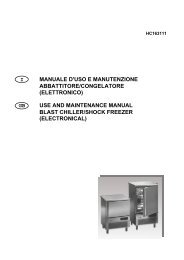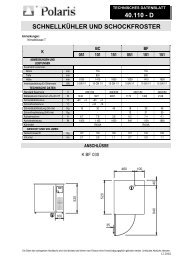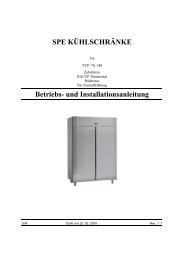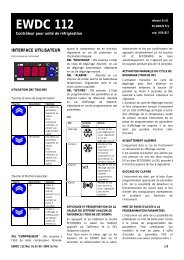K/KU TN 70/72 K/KU TNV 70/140
K/KU TN 70/72 K/KU TNV 70/140
K/KU TN 70/72 K/KU TNV 70/140
Create successful ePaper yourself
Turn your PDF publications into a flip-book with our unique Google optimized e-Paper software.
START-UP AND DISPOSAL OF UNIT<br />
CONTENTS:<br />
1.0 - PRELIMINARY CONTROLS<br />
1.1 - GENERAL CONTROLS<br />
1.2 - CONTROL OF ELECTRICAL SYSTEM<br />
2.0 - START-UP - CHECKS<br />
3.0 - DISPOSAL OF UNIT<br />
IMPORTANT<br />
BEFORE CONNECTING THE APPLIANCE CHECK THAT THE DATA ON THE SERIAL PLATE CORRESPOND TO THE<br />
ACTUAL ELECTRICAL SUPPLY.<br />
THE SERIAL PLATE GIVING THE ELECTRICAL DATA REQUIRED IN THE INSTALLATION IS FOUND ON THE TOP<br />
RIGHT-HAND SIDE OF THE FRONT CONTROL PANEL.<br />
THE INSTALLATION MUST BE MADE ACCORDING TO THE INSTRUCTIONS GIVEN IN THIS SECTION, BY<br />
PROFESSIONALLY QUALIFIED PERSONNEL.<br />
THE ELECTRICAL SAFETY OF THIS APPLIANCE IS ONLY GUARANTEED WHEN IT IS CONNECTED TO AN EFFICIENT<br />
EARTHING PLANT AS PRESCRIBED BY EXISTING ELECTRICAL SAFETY REGULATIONS.<br />
THIS FUNDAMENTAL SAFETY REQUIREMENT MUST BE VERIFIED AND, IF IN DOUBT, REQUEST A PRECISE<br />
CONTROL OF THE PLANT BY PROFESSIONALLY QUALIFIED PERSONNEL.<br />
THE CONSTRUCTOR DECLINES ALL RESPONSIBILITY FOR DAMAGES CAUSED BY THE DISRESPECT OF AN<br />
EFFICIENT EARTHING OF THE PLANT.<br />
THE APPLIANCE MUST ALSO BE FITTED WITH AN EQUIPOTENTIAL SYSTEM WHOSE EFFICIENCY MUST BE<br />
VERIFIED ACCORDING TO EXISTING REGULATIONS.<br />
THE USE OF ADAPTERS, MULTI-PLUGS, AND/OR EXTENSION LEADS IS STRICTLY PROHIBITED<br />
1.0 - PRELIMINARY CONTROLS<br />
1.1 - GENERAL CONTROLS<br />
1.1.1 - Control the appliance is perfectly level. Regulate the<br />
adjustable feet if necessary.<br />
1.1.2 - Control that the plastic protective coating is removed<br />
from all external surfaces.<br />
1.1.3 - Control that the interior is washed with warm water<br />
and a neutral soap.<br />
1.1.4 - Control that the appliance is positioned as far as<br />
possible from heat sources.<br />
1.1.5 - Control that the free air circulation around the motor<br />
compartment is not obstructed.<br />
1.1.6 - Control that the locking keys are beyond the reach of<br />
children.<br />
1.2 - CONTROL OF THE ELECTRIC SYSTEM<br />
1.2.1 - Control the voltage and frequency of the mains<br />
distribution :<br />
THEY MUST FALL WITHIN THE GIVEN VALUES<br />
230 ± 10% 50Hz<br />
1.2.2 - Tighten all the screws that fix the wires to the electrical<br />
components ( vibrations during handling and transport could<br />
have loosened them ).<br />
1.2.3 -Check that there is a circuit breaker before the socket<br />
with an opening distance of the contacts equal to or over 3<br />
mm.<br />
1.2.4 - Turn the main switch to the OFF position where the<br />
power cable plug will be connected.<br />
1.2.5 -Check the compatibility of the socket with the plug of<br />
the appliance. If necessary, have it changed by professionally<br />
qualified personnel. The technician should also check<br />
that the cable section to the socket is adequate for the<br />
absorbed power of the appliance.<br />
Check that the plug is in the socket.<br />
Pag. 20<br />
2.0 - START-UP - CHECKS<br />
After the above controls have been thoroughly completed<br />
the appliance may be started-up :<br />
2.1.1 - Turn the main switch, connected to the power cable<br />
plug, to the ON position.<br />
2.1.2 - Turn the switch of the appliance to the ON position.<br />
2.1.3 - Visualise the SET POINT.<br />
2.1.3.1 - Press the SET � button on the electronic thermostat<br />
checking that the LED set � is flashing;<br />
2.1.3.2 - Set the desired value, based on the type of product<br />
being stored.<br />
To modify the factory setting of this value consult the CON-<br />
TROL PANEL section (page 18).<br />
IMPORTANT<br />
BEFORE INTRODUCING FOOD ALLOW THE APPLIANCE<br />
TO REACH STABLE OPERATING CONDITIONS.<br />
3.0 - DISPOSAL OF UNIT<br />
To dispose of this appliance, before it is scrapped it must be<br />
rendered unoperational by removing the power cable, eliminating<br />
all parts of the appliance that could constitute a hazard<br />
and invalidate the lock, hinge and any other closing devices<br />
to avoid that children playing could be trapped inside or<br />
injured.<br />
IMPORTANT<br />
RESPECT LOCAL REGULATIONS REGARDING<br />
SCRAPPING OF THIS TYPE OF APPLIANCE.



